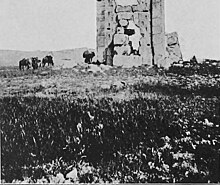Cassandane
| Cassandane | |
|---|---|
 An old image of a possible tomb of Cassandane in Pasargad Archaeological Site Suleiman Prison (Pasargad) 1906 image taken from the book Persia past and present by AV Williams Jackson (1906) | |
| Queen consort of the Achaemenid Empire | |
| Tenure | 559–538 BC |
| Coronation | 559 BC |
| Successor | Atossa |
| Died | 538 BC |
| Burial | |
| Spouse | Cyrus the Great |
| Issue | Cambyses II Bardiya Artystone Atossa Roxane |
| House | Achaemenid |
| Father | Pharnaspes |
Cassandane or Cassandana (died 538 BC) was a Persian Achaemenian shahbanu and the dearly loved wife of Cyrus the Great.[1]
She was a daughter of Pharnaspes. She had four children with Cyrus: Cambyses II, who succeeded his father and conquered Egypt; Smerdis (Bardiya), who also reigned as the king of Persia for a short time; a daughter named Atossa, who later wed Darius the Great; and another daughter named Roxana.[2]
Her daughter Atossa later played an important role in the Achaemenid royal family, as she married Darius the Great and bore him the next Achaemenid king, Xerxes I.[3]
When Cassandane died, all the nations of Cyrus' Persian empire observed "a great mourning". This is reported by Herodotus. According to a report in the chronicle of Nabonidus, there was a public mourning after her death in Babylonia lasting for six days. Cassandane reportedly stated that it was more bitter to leave Cyrus's side than to die.[4] Cyrus demanded his kingdom mourn her death: [5] according to the Nabonidus Chronicle, this lasted six days (identified as 21–26 March 538 BC).[6] According to a suggestion by M. Boyce, Cassandane's tomb is located at Pasargadae.[2]
Notes[edit]
- ^ https://www.iranicaonline.org/articles/cassandane-wife-of-cyrus-ii-q
- ^ a b Dandamaev, M. A. (1992). "Cassandane". Encyclopaedia Iranica. Vol. 5. Encyclopaedia Iranica Foundation. ISBN 0-933273-67-3.
- ^ Schmitt, Rüdiger (1989). "Atossa". Encyclopaedia Iranica. Vol. 3. Encyclopaedia Iranica Foundation. ISBN 0-7100-9121-4.
- ^ Benjamin G. Kohl; Ronald G. Witt; Elizabeth B. Welles (1978). The Earthly republic: Italian humanists on government and society. Manchester University Press ND. p. 198. ISBN 978-0-7190-0734-7.
- ^ Kuhrt 2013, p. 106.
- ^ Grayson 1975, p. 111.
Bibliography[edit]
- Kuhrt, Amélie (2013). The Persian Empire: A Corpus of Sources from the Achaemenid Period. Routledge. ISBN 978-1-136-01694-3.
- Grayson (1975), Assyrian and Babylonian Chronicles

